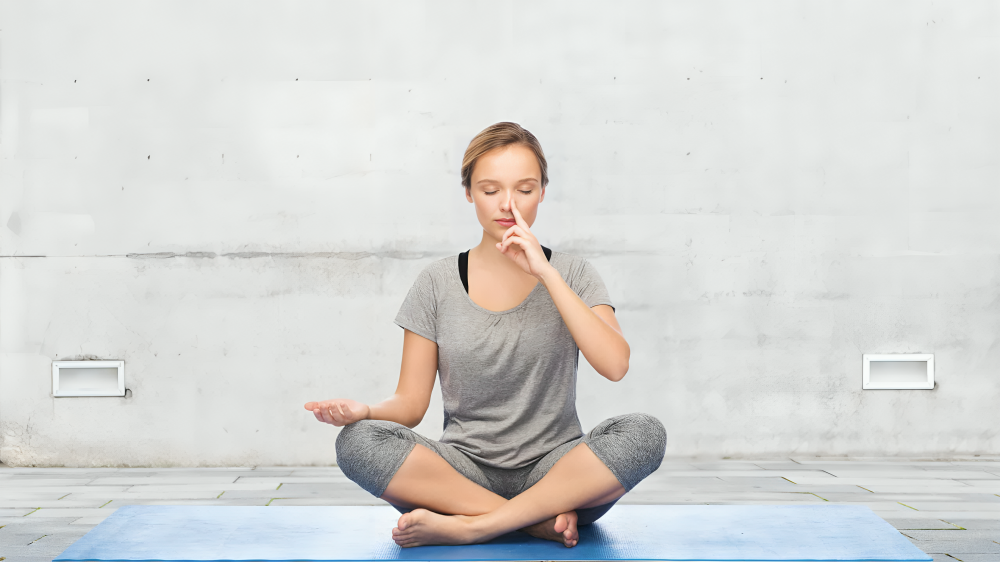
What is Kevala Kumbhaka Pranayama
At its core, Kevala Kumbhaka refers to “breath retention without inhalation or exhalation.” It’s a state of natural stillness, where the practitioner holds their breath effortlessly, without actively controlling it. Unlike other pranayama techniques where breath is consciously regulated, Kevala Kumbhaka is a spontaneous pause in breathing. It’s considered an advanced pranayama technique because it allows the mind and body to reach a state of deep calm and heightened awareness.
How to Practice Kevala Kumbhaka Pranayama
Find a Quiet Space:
Sit comfortably in a cross-legged position, or on a chair with your spine straight. Make sure you’re in a calm, distraction-free environment.
Practice Basic Pranayama First:
Start with Nadi Shodhana (alternate nostril breathing) or Ujjayi Pranayama (victorious breath). These breathing exercises help you regulate your breath, focus your mind, and prepare you for breath retention.
Slow Down Your Breathing:
Gradually slow your breath until it feels smooth and even. Aim for an equal duration of inhalation and exhalation.
Initiate Retention (Kumbhaka):
After inhaling, gently hold your breath. Start with short holds (2-3 seconds) and gradually increase the duration. Don’t force it—comfort is key here.
Gradually Move Toward Effortless Breath Retention:
As you practice, you’ll notice that breath retention feels more natural. Kevala Kumbhaka occurs when this retention happens without effort, but it takes time, patience, and practice to get there.
Be Patient and Consistent:
Regular practice helps you develop the ability to comfortably retain your breath. Over time, you may reach a state where your breath naturally pauses without any conscious control.
Benefits of Kevala Kumbhaka Pranayama
Deep Mental Calm
One of the primary benefits of Kevala Kumbhaka is the deep sense of calm it brings. By suspending your breath, you allow your mind to pause, which reduces mental chatter and stress. This makes it a powerful tool for managing anxiety and improving focus.
Increased Lung Capacity
Holding your breath for longer periods gradually improves your lung capacity. This helps you take in more oxygen with each breath, which can be especially beneficial for athletic performance and overall vitality.
Boosts Energy Levels
Kevala Kumbhaka is known to increase prana (life force energy) in the body. This results in higher energy levels and can leave you feeling more refreshed and rejuvenated.
Enhances Mental Clarity and Awareness
When your breath becomes still, so does your mind. This heightened awareness allows you to experience sharper mental clarity and focus, making it easier to tackle complex tasks or meditate deeply.
Promotes Emotional Balance
Breath retention can help balance emotions by calming the nervous system. Over time, this practice can make you feel more emotionally stable and better equipped to handle stressful situations.
Connection to Spiritual Practices
Many yogis believe that Kevala Kumbhaka Pranayama leads to spiritual awakening. The state of breathlessness is seen as a pathway to experiencing inner peace and a deeper connection to the self or the universe.
It’s here Sukha Purvaka Pranayama How to do it and what are the Benefits
FAQs
Q1. Can beginners practice Kevala Kumbhaka?
Yes, but it’s recommended to start with basic pranayama techniques before attempting Kevala Kumbhaka. It’s an advanced practice, so take your time to work up to it.
Q2. How long does it take to master Kevala Kumbhaka?
There’s no set timeline—it depends on your consistency and comfort level. Some people may feel comfortable after a few months of practice, while others may take longer.
Q3. Can Kevala Kumbhaka be dangerous?
Kevala Kumbhaka is generally safe if done correctly. However, it’s important to listen to your body and avoid pushing your limits. Practicing under the guidance of a teacher can be helpful.
Q4. How often should I practice?
You can practice pranayama daily, but when starting out, practice breath retention for short periods (a few minutes). Gradually build up the time as you grow more comfortable.

